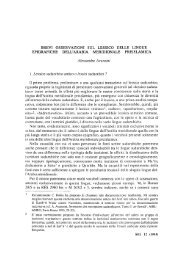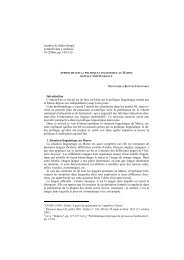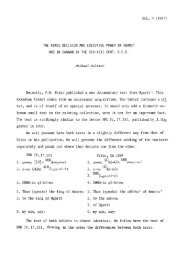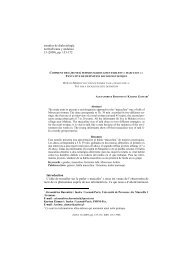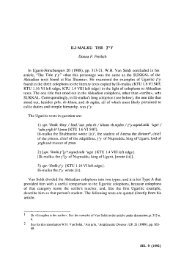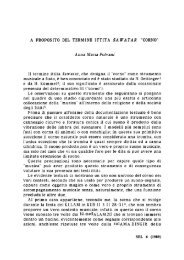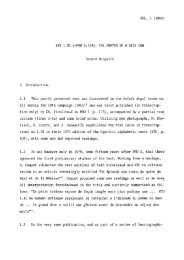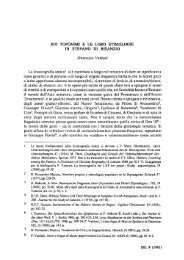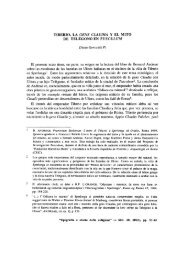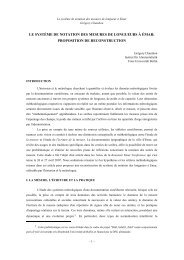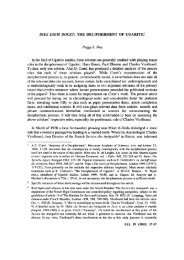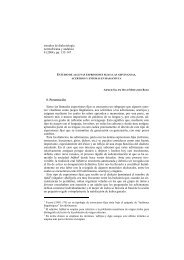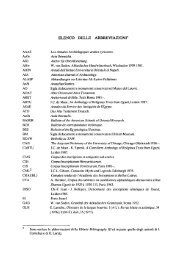WEST SEMITIC NAMES IN THE ASSYRIAN EMPIRE DIFFUSION ...
WEST SEMITIC NAMES IN THE ASSYRIAN EMPIRE DIFFUSION ...
WEST SEMITIC NAMES IN THE ASSYRIAN EMPIRE DIFFUSION ...
You also want an ePaper? Increase the reach of your titles
YUMPU automatically turns print PDFs into web optimized ePapers that Google loves.
<strong>IN</strong>TRODUCTION<br />
<strong>WEST</strong> <strong>SEMITIC</strong> <strong>NAMES</strong> <strong>IN</strong> <strong>THE</strong> <strong>ASSYRIAN</strong> <strong>EMPIRE</strong><br />
<strong>DIFFUSION</strong> AND SOCIAL RELEVANCE<br />
Frederick Mario Fales<br />
In 1978, upon the occasion of a Rencontre Assyriologique Internationale on<br />
«Mesopotamien und seine Nachbarn», two separate contributions, by P. Garelli and<br />
H. Tadmor, were devoted to the Arameans in the Neo-Assyrian empire 1 . Both of<br />
these studies - which surprisingly enough overlapped only to a small extent despite<br />
their limited common topic - consisted of bird's-eye views on the presence of the<br />
Aramaic linguistic and cultural component within the Assyrian empire. Specifically,<br />
albeit to different degrees, both studies made use of onomastics to demonstrate the<br />
penetration of Arameans within all levels of Assyrian society. This was done by<br />
means of selections of onomastic material from various archives of the NA period<br />
made quite at random - names from the 8th and from the 7th century, from<br />
Nimrud/Kalhu as well as from Nineveh, from older compilations as well as from<br />
newly published texts.<br />
In any case, selective procedures apart, the overall historical framework which<br />
ensued from both studies was by and large comparable, and altogether functional for<br />
setting «onto paper» what had previously constituted a series of separate insights on<br />
the part of the interested specialists: that Assyria was the first of the Near Eastern<br />
empires to show a true Aramaic «layer». Both Garelli and Tadmor evoked a broad<br />
presence of Arameans in the territories of the Assyrian empire, and especially in<br />
Mesopotamia 2 : and, as evidence for this trend, not only the personal names, but also<br />
the progressive use of alphabetic script, and also the (suggested) influence of specific<br />
Aramaic cultural traditions on Assyria were brought forth. In brief, then, the authors<br />
proposed as a common outline that the Arameans «gradually transformed the cultural<br />
face of the Empire» 3 so as to make it in fact definable as «un empire assyroarameen»<br />
4 .<br />
P. Garelli, Importance et role des Aram6ens dans Vadministration de Vempire assyrien, in H.-J.<br />
Nissen-J. Renger (Hrsgg.), Mesopotamien und seine Nachbam, Berlin 1982, pp. 437^7; H.<br />
Tadmor, The Aramaization of Assyria: Aspects of Western Impact, in ibid., pp. 449-70.<br />
Cf. e.g. Tadmor, ciL, p. 450: «One finds Westerners' in various sectors of Assyrian society and<br />
though precise statements cannot be made for lack of prosopographical - statistical studies, it may<br />
not be an overstatement to say that they had penetrated even into the high-ranking officialdom as<br />
provincial governors and /xm/nu-holders».<br />
Tadmor, ciL, p. 459.<br />
Garelli, ciL, p. 444.<br />
SEL8(1991)
100 F.M. Fales<br />
In the intervening years since that felicitous Rencontre, a number of developments<br />
- the impact of which is probably rather cumulative than individual - have marked<br />
the field of «Assyro-aramaica». Although R. Zadok's seminal work on West Semitic<br />
onomastics in the NB/LB periods (with many a reference to Neo-Assyrian) was<br />
already (although just) out in 1978 5 , its impact was actually felt in the course of the<br />
next few years, also in connection with a series of collateral contributions on non-<br />
Semitic onomastic components of the same corpus 6 . At the same time, other scholars<br />
had analyzed this or that aspect of the NA name-corpus, also in correlation with the<br />
contemporary alphabetic attestations 7 .<br />
As for the general image of «Assyro-aramaica», various different aspects have<br />
been dealt with in the past few years. On one hand, the publication of a new bilingual<br />
inscription on a statue from Syria 8 has provided important new data on the origins of<br />
the linguistic/cultural symbiotic process between Akkadian and Aramaic - notably as<br />
regards the correlations of lexicon 9 and stylistics 10 . Further, the official nature of the<br />
inscription - drawn up by a local potentate self-styled as mlk in Aramaic but as Saknu<br />
in Akkadian - has opened up interesting new problems of historical context 11 .<br />
3 R. Zadok, On West Semites in Babylonia During the Chaldean and Achaemenian Periods,<br />
Jerusalem 1977,1978 2 (henceforth =WSB).<br />
6 R. Zadok, Phoenicians, Philistines, and Moabites in Mesopotamia: BASOR, 230 (1978), pp. 57-<br />
65; id., On Some Foreign Population Groups in First-Millennium Babylonia: Tel Aviv, 6 (1979),<br />
pp. 164-81; id., Arabians in Mesopotamia During the Late-Assyrian Chaldean, Achaemenian and<br />
Hellenistic Periods Chiefly According to the Cuneiform Sources: ZDMG, 131 (1981), pp. 42-84;<br />
id., A Tentative Structural Analysis ofElamite Hypocoristica: BeitrSge zur Namenforschung, 18<br />
(1983), pp. 93-120; etc.<br />
' Cf. e.g. F.M. Fales, A List of Assyrian and West Semitic Women's Names : Iraq, 41 (1979), pp.<br />
55-73; id., L'enigmatico QYRH : Annali di Ca' Foscari, 19/3 (1981), pp. 7-14; id., Assiro e<br />
aramaico: filologia e interferenza Unguistica: Atti del Sodalizio Glottologico Milanese, 25 (1984),<br />
pp. 21-30; E. Lipinski, La correspondance des sibilantes dans les textes aram6ens et les textes<br />
cuneiformes n6o-assyriens, in P. Fronzaroli (Ed.), Atti del II Congresso Intemazionale di<br />
Linguistica Camito-Semitica, Firenze 1978, pp. 201-10; id, Les Ph6niciens a Ninive au temps des<br />
Sargonides: Ahoubasti,portier en chef, in ACFP 1,1, pp. 125-34; id., Aramaic-Akkadian Archives<br />
from the Gozan-Harran Area, in J. Amitai (Ed.), Biblical Archaeology Today, Jerusalem 1985,<br />
pp. 340-48. For onomastics in Aramaic alphabetic script, cf. at present M. Maraqten, Die<br />
semitischen Personnennamen in den alt- und reichsaramSischen Inschriften aus Vorderasien,<br />
Hildesheim 1988, with previous bibliography.<br />
* A. Abou Assaf-P. Bordreuil-A.R. Millard, La statue de Tell Fekheriye et son inscription bilingue<br />
assyro-arame'enne,Paris 1982.<br />
9 Cf. e.g. J.C. Greenfield-A. Shaffer, Qlqlt', tubkinnu, Refuse Tips and Treasure Trove: AnSt, 33<br />
(1983), pp. 123-29; idd., Notes on the Akkadian-Aramaic Bilingual Statue from Tell Fekherye:<br />
Iraq,45 (1983), pp. 109-16.<br />
10 F.M. Fales, Le double bilinguisme de la statue de Tell Fekheriye: Syria, 40 (1983), pp. 233-50.<br />
1 * Cf. e.g. M. Liverani, The Growth of the Assyrian Empire in the Habur/Middle Euphrates Area: A<br />
NewParadigm: SAAB, 2 (1988), pp. 81-98.
West Semitic Names in the Assyrian Empire 101<br />
On the other hand, in 1986 we personally republished the Aramaic inscriptions on<br />
clay tablets of this period 12 - limited 13 but crucial testimonials to the process of<br />
Aramaization in the Assyrian empire - thus providing a necessary updating to the<br />
editio princeps by L. Delaporte 14 and the error-riddled compilation by F. Vattioni 15 .<br />
The very tight correlation between the Aramaic and the Assyrian portions of these<br />
texts, that had escaped previous commentators, was productive for the elucidation of<br />
the documents 16 and for the building up of a common «horizon» of technical terms<br />
and mutual linguistic interferences 17 .<br />
Finally, a number of contributions - blending together philological and historical<br />
aspects - have addressed the problem of the Assyrian ade and the Aramaic 'dy, which<br />
Tadmor had openly classified as an Aramaic institution borrowed by the Assyrians in<br />
the second quarter of the 8th century B.C. 18 . Tadmor himself and quite a few others<br />
have subsequently come back to this institutional theme and the texts - both Assyrian<br />
and Aramaic - which elucidate it, with a variety of results 19 . It is indisputable that the<br />
^ F.M. Fales, Aramaic Epigraphs on Clay Tablets of the Neo-Assyrian Period, Roma 1986<br />
(henceforth = AECT).<br />
13 In the main, these inscriptions are 1-2 line summaries engraved on the free margins of cuneiform<br />
documents of legal content, giving the bare essentials of the relevant juridical transaction.<br />
14 L. Delaporte, Epigraphes aramSens, Paris 1912.<br />
15 F. Vattioni, Epigrafia aramaica: Augustinianum, 10 (1970), pp. 433-52; ibid., 11 (1971), pp. 18-<br />
190; OrNS, 48 (1979), pp. 140-45.<br />
16 This edition has now been included in the new and courageous editorial venture of the<br />
Comprehensive Aramaic Lexicon (CAL) currendy being prepared by S.A. Kaufman, D.R. Hillers,<br />
and J.A. Fitzmyer. Unfortunately, however, a review-article of the book by Kaufman himself<br />
(Assyro-aramaica: JAOS, 109 [1989], pp. 97-102) offers suggestions on reading and interpretation<br />
which, not being based on a recollation of the text, represent in a certain number of cases a step<br />
backward in the process of elucidation of this material. Overall, the following suggestions of<br />
Kaufman's seem sound: nos. 5, 31, 53 (1. 5). On the other hand, the following ones are risky, i.e.<br />
exceedingly conjectural: nos. 13 (where eleven missing characters are ^confidently* restored), 15<br />
(where nbdry is made to become knwny!). Finally, the following ones are erroneous and/or misleading<br />
as concerns either Neo-Assyrian philology or Aramaic epigraphy: nos. 28 (unjustified<br />
interpretation of qdm byt as SAG.MES!), 30 (restorations, which take in no account copies of the<br />
texts from CIS to Delaporte to Stevenson, well before ours!), 38 («armchair» comparison of our<br />
copy with Millard's); 45 (new interpretation, which according to K. himself, «makes little<br />
sense»!), 50 (a glance at the [ugly] photo on pi. XVI, no. 6 suffices to see the -y).<br />
17 AECT deals with the Neo-Assyrian «half» of Delaporte's edition, integrating the 1912 corpus with<br />
numerous exemplars published since that time. For the Neo- and Late-Babylonian epigraphs, a<br />
full edition of Delaporte's and later materials (including unpublished pieces) is now in a final<br />
stage of preparation by Eleonora Cussini (publication foreseen for 1992).<br />
1° Tadmor, tit, p. 457.<br />
1" Cf. in general A. Lemaire-J.M. Durand, Les inscriptions aramiennes de Sfir6 et VAssyrie de<br />
Shamshi-ilu, Geneve-Paris 1984; K. Watanabe, Die zte-Vereidigung anlMsslich der Thwnfolgeregelung<br />
Asarhaddons, Berlin 1987, pp. 6-25, with previous bibl.; S. Parpola, in S. Parpola-K.<br />
Watanabe, Neo-Assyrian Treaties and Loyalty Oaths (=SAA II), Helsinki 1988, pp. xv-xxv; H.<br />
Tadmor, Alleanza e dipendenza nell'antica Mesopotamia e in Israele: terminologia eprassi, in L.<br />
Canfora-M. Liverani-C. Zaccagnini (a cura di), / trattati nel mondo antico. Forma ideologia<br />
funzione, Roma 1990, pp. 17-36; J.A. Brinkman, Political Covenants, Treaties, and Loyalty Oaths
102 F.M. Fales<br />
discussion on ade-'dy, in itself far from being over, has led to a series of collateral<br />
reflections and points of view on the internal and external relations and policies of the<br />
Assyrian empire.<br />
Thus, «Assyro-aramaica» has decidedly spread its roots in ancient Near Eastern<br />
studies, with an ever-growing range of contributions, especially philological but not<br />
exclusively so 20 . But the intervening years since Garelli and Tadmor's evaluation of<br />
Aramaic personal names within Assyrian society have also been marked by an<br />
extraordinary flourishing of text-editions of NA material. While up-to-date editions<br />
available in 1978 were still quite limited, today a series of critical editions (State<br />
Archives of Assyria, directed by Simo Parpola) is rapidly filling up gaps in our<br />
knowledge of the documentary corpus of Neo-Assyrian 21 , flanking a number of<br />
equally significant periodical or sporadic publications 22 .<br />
* * *<br />
The time thus seems ripe to cast a new glance at the issue of the presence and<br />
attestation of Arameans within the Assyrian empire: and the occasion allows us to go<br />
back to Aramaic (and more in general West Semitic) onomastics, although in a nonrandom,<br />
and less impressionistic, vein. Our attempt in this contribution will be to<br />
examine a number of different samplers from archives or corpuses of the NA period<br />
from the 8th and 7th centuries B.C. in their onomastic components, both of West<br />
Semitic affiliation and not In other words, we will attempt a quantitative evaluation<br />
of these samplers, so as to give a general picture of the relative diffusion of West<br />
Semitic names within the total number of onomastic attestations. But there is also a<br />
further side to this approach: since the «situational» setting of these archives is that of<br />
administration or law, the focus of the samplers will almost automatically fall on<br />
people visualized in groups, determined either by reasons of kinship, or by professional<br />
comradeship, or by mere local contiguity.<br />
Thus the attempt will include evaluating the diffusion of West Semitic personal<br />
names within groups of parentage or of contemporaries, as they appear in the<br />
selected samplers from different chronological phases of the Assyrian empire. The<br />
in Babylonia and between Assyrian and Babylonia, in ibid., pp. 81-111; M. Liverani,<br />
Terminologia e ideologia del patto nelle iscrizioni reali assire, in ibid., pp. 113-47; F.M. Fales,<br />
Istituzioni a confronto tra mondo occidentale e Assiria nel Imillennio a.C: il trattato di Sefire, in<br />
ibid, pp. 149-73.<br />
Cf. further, e.g., J.C. Greenfield, Ana urduU kabasu = kbs I'M: StOr, 55 (1984), pp. 259-63; A.R.<br />
Millard, Assyrians and Arameans: Iraq,A5 (1983), pp. 105-108.<br />
At the time of writing, vols. I-V of the series State Archives of Assyria (=SAA), comprising<br />
official correspondence, treaties, political-religious texts, and political-literary material, have<br />
been published.<br />
As for other regular publications in the field, cf. the journal State Archives of Assyria Bulletin<br />
(Padua), linked to the SAA project, and the series of text-editions in volume form Cuneiform<br />
Texts from Nimrud (London), henceforth CTN. Notice also F.M. Fales, Cento lettere neo-assire,<br />
Venezia 1983; K. Watanabe, Die ade- Vereidigung, cit, and T. Kwasman, Neo-Assyrian Legal<br />
Documents in the Kouyunjik Collection of the British Museum, Roma 1988 (=henceforth NALK).
West Semitic Names in the Assyrian Empire 103<br />
question that will be posed as concerns these people and these groups is the<br />
following: what overall picture may be obtained as concerns the numerical and social<br />
importance of the West Semitic onomastic component in the overall population of the<br />
Assyrian empire? Agreeing to the fact that the West Semitic (and specifically<br />
Aramaic) onomastic element was represented in this general time and place, just how<br />
well was it represented? And were there variations in name-giving habits in the<br />
course of time which affected the diffusion of these onomastics? Were there<br />
particular niches, both geographical and social, where West Semitic names seem<br />
more frequently attested, and others in which they seem to be rare?<br />
SAMPLERS OF PROFESSIONAL GROUPS<br />
(a) <strong>THE</strong> ARMY OF SARGON<br />
Let us start out this inquiry by examining a recently published corpus, the<br />
administrative texts stemming from the so-called «Fort Shalmaneser» building of<br />
Nimrud 23 . We would choose in particular TFS 99, the main list of army personnel of<br />
the age of Sargon II (722-705 B.C.) in which a number of «team-commanders» (rab<br />
urate) are listed, in 13 sections 24 representing separate units, next to their higher<br />
officials 25 : altogether, 184 names are given.<br />
In this quite respectable sampler, the West Semitic element is relatively well<br />
represented: even not taking into account quite a few uncertain cases, our tally came<br />
to 41 names, i.e. 22.3% of the total 26 . More in detail, it may be useful to note that two<br />
units are indicated in this text as being of a specific provenience, i.e. a «Chaldean»<br />
group 27 and a «Samarian» group 28 , while others are undefined as such. Now, both the<br />
Chaldean and the Samarian group show - as expected - a marked presence of West<br />
Semitic onomastics: we find Ahi-di-ki-ri, Nur-ia-pa-a, and A-a-fu-ri in the Chaldean<br />
23 S. Dalley-J.N. Postgate, The Tablets from Fort Shalmaneser (=CTN III), London 1984<br />
(henceforth =TFS).<br />
24 Classified A to N by Dalley and Postgate; section I, however, is formed by only one (unclear)<br />
word.<br />
25 Discussion on the title G AL.G AlJMES ^ provided in TFS, p. 171.<br />
2 " The list is the following (roots marked only in problematical cases, else cf. Zadok, WSB): Pa-qihi,<br />
d.NU-i/n-me, Si-ia-u (Y/W$Y imperative + theoph./hypocor. element), Gu-u-a (*G > Y/H), Atar-Su-ki,<br />
AD-di-ki-ri,Sa-al-t[i-Dl]NGlR,Mah-di-e,Ia-ta-ra,Ha-S^-na,\J-im-me,Ka-pdr-ra, Atar-ba-a-di,<br />
Si-id-qa-a-a,D<strong>IN</strong>GlR-da-Ia-a, PAP-di-ki-ri,ZALAG-ia-pa-a, d.A-a-/u-ri, Ib-ba-da-laa,<br />
Da-7a-PAP, Ia-u-ga-a, PAP-id-ri, Ab-di-mil-ku, Na-ar-me-na-a (cf. Zadok: BiOr, 42, p. 567),<br />
Gab-bi-e, Sa-mal-a,PAP-id-riII, Ba-/ii-e,PAP-i-u, Ba-ri-ki,PAP-la-ra-me,U-hat-ti, Gab-ba-ru,<br />
A-tar-ra-hi-i\, Mil-ki-ia-ta-a, Sa-al-u-DTNGTR.n,A-ba-a,d.A-ra-mu, Hi-da-ta-a-nu, Ha-busu,<br />
Ba-hi-L Notice, by die way, that the presumed Bal-nam-he, Rev. Ill, 8, should be read Pal-hu\-<br />
Sel-zibi<br />
2 ' TFS 99: II, 12-15. The origin of this group in Sargon's army is discussed in TFS, p. 177, adD.<br />
28 TPS 99: n, 16-23. On the Samarian group, cf. most recently I. Eph'al, «The Samarian(s)» in the<br />
Assyrian Sources, in Festschrift H. Tadmor, Jerusalem 1991, pp. 36-45.
104 F.M. Fales<br />
unit (3 out of 7), and Ib-ba-da-la-a, Da-/a-ahi, Ia-u-ga-a, Ahi-id-ri, Ab-di-mil-ku, Naar-me-na-a<br />
29 , Gab-bi-e, Sa-ma 7-a, Ahi-id-ri n, Ba-hi-e, and Ahi-i-u, in the Samarian<br />
unit (11 out of 13) 30 . However, it is a further unit, attached to one Kakku-Sarru-usur,<br />
which is particularly impressive, since - apart from a man called Kal-bu, of<br />
undetermined Semitic affiliation - all its components bear West Semitic names (8 out<br />
of 9) 31 . In other groups, West Semitic presences decrease sharply, to the point of total<br />
absence in favor of the typical Assyrian component (e.g. section K, Rev. HI 13-16;<br />
section N, ibid., 23-25).<br />
Thus, in brief, this Nimrud sampler would seem to indicate that Sargon's army (a)<br />
had at least one-fifth of its components bearing West Semitic names, and that (b) it<br />
was divided into professional sectors or units which at times were marked by common<br />
linguistic-cultural origins or references. In other such groups or units, a process of<br />
admixture, in which the West Semitic onomastic element was a relative rarity in a<br />
mass of purely Assyrian formations, seems to have been underway.<br />
(b) ESARHADDON'S MILITARY PERSONNEL<br />
As a second sampler of professional groups in the Neo-Assyrian period, let us take<br />
up a further text of administrative character: ADD 857, the largest list of military<br />
personnel of Esarhaddon's time, relevant to people attached to the households of the<br />
queen mother and the crown prince 32 . The document, which has a few broken lines,<br />
bears 114 names of middle-rank military. Quite a few of these names are also<br />
For an interpretation of this name as «servant of Mny», cf. Zadok: BiOr, 42, p. 567; but notice the<br />
variant in TFS 108: III, 40, ar-me[-na-a], which would imply that the n- was prosthetic.<br />
Most recent discussion of these names by Eph'al, ciL, pp. 41-42. One may be in agreement with<br />
this author when he states that in this group «only a few of the names can be considered Israelite»<br />
(p. 42). Notice, however, the following conclusion: «it seems preferable to associate most of the<br />
above-mentioned 'Samarians' with the foreigners who were transferred to the province of<br />
Samirina ... , rather than with the Israelites exiles in Assyria» (ibid.). In a subsequent footnote<br />
(ibid., fn. 38), a scruple prompts the author to state that «for the sake of balance and completeness<br />
we should note that... the northern, Israelite onomasticon (of which only a relatively small portion<br />
has survived) is not replete with Yahwistic names*. The conclusions are nonetheless still<br />
categorical: «It is certain, however, that Aramaic and Akkadian names such as Ahu-idri, Atamru,<br />
Bahe\ Bel-duri, Gabbe and Narmena were not included in the Israelite onomasticon». Eph'al's<br />
slightly circular reasoning fails to take into account the very concrete possibility that people may<br />
take on second names or entirely new names to adapt to new linguistic and societal settings - as<br />
e.g. many immigrants from Europe do in modern-day Israel. And moreover, since Sargon claims<br />
to have taken 27,290 people captive at Samaria and states that he added them to his army (cf. B.<br />
Oded, Mass Deportations and Deportees in the Neo-Assyrian Empire, Wiesbaden 1979, p. 52, for<br />
references and discussion), one wonders where else would they have ended up, if not in the<br />
«Samarian» contingent listed here!<br />
TFS 99: II, 7-11, section C (the group reappears in TFS 108: III, 7-11; notice there Kal-bi-i for<br />
Kal-bu). Cf. also section M (rev. Ill, 17-22) for a fair-sized West Semitic presence.<br />
Cf. for the moment, LAS II, 459, where a date ca. 670 B.C. is suggested. The text will be included<br />
in the forthcoming critical edition of Ninevite administrative texts by F.M. Fales and J.N.<br />
Postgate (SAA 7/1, Helsinki 1991).
West Semitic Names in the Assyrian Empire 105<br />
attested in other administrative schedules of the age, thus clarifying the fact that this<br />
was regular palace personnel 33 .<br />
In this particular case, the result of an inquiry into the personal names of a<br />
professional group is interestingly clear-cut. West Semitic names are quite scarce in<br />
this Esarhaddon list, not reaching even 20 examples, with an overall percentage of<br />
16.7% 34 . We have counted the following, which - as may be seen - comprise even a<br />
few doubtful cases: Ab-di-li-mu LU2-[x x x] (i, 44) 35 ; Ha-nu-nu ILLEGAL ki-sirGAL<br />
SAG (ii, 10); Gu-lu-su\JJ2.GAR-nuI-tu-'u (ii, 11); Se-{e'l-qal-m\u LU2.qur-but(u)<br />
(ii, 22); tfa-am-[x]x-suLU2.ENGIS.GIGIR (ii, 23); A-da\-a LU2 Sa GIR3.ii (ii, 26);<br />
Sa-lam-a-nuL[U2.GAL] ki-sir AMA.MAN (ii, 31); Ga--a' L[U2].qur-but(u)<br />
(ii, 34); Da-n;-iL[U2].A.BA (ii, 40); Ha-di-duLU2.qur-but(u) (ii, 48); Bu-lu-zak-ru<br />
LU2.SAG (ii, 49); Ar-ba-a.a LU2.EN.NAM (ii, 50); Ahi-i-[
106 F.M. Fales<br />
parallel with other inventories of palace personnel 41 , while a few of the names also<br />
occur in contemporary letters in connection with royal activity 42 : so there can be no<br />
ground to suppose that a non-representative context was involved here. In the light of<br />
the fact that this was actually an official list of Esarhaddon's court personnel, then, the<br />
probability that a social, or socio-cultural, cause lay behind the scarcity of the West<br />
Semitic onomastic component in the text, should be taken into account.<br />
In order to make the picture clearer, further samplers will be at this point taken up<br />
for consideration. From the legal texts discovered in the royal capital Nineveh<br />
(essentially of the 7th century B.C.), a series of deeds has been recently re-edited<br />
with an eye to inner subdivisions in «archives» 43 . From this corpus, it is possible to<br />
draw a wide variety of names, moreover falling in different types of groupings. We<br />
have specifically chosen two distinct samplers: the first sampler - in itself twofold -<br />
concerns groups formed by «neighbors and friends», i.e. people who are associated on<br />
a local basis or on the basis of acquaintance; while the second refers to people linked<br />
by ties of kinship.<br />
SAMPLERS OF «NEIGHBORS AND FRIENDS»<br />
The «neighbors and friends» groups are, of course, characterized in common per<br />
differentiam as regards groups united by blood ties: here it was society, and not kinship,<br />
which associated the people involved, in different degrees of chance/necessity.<br />
Going into further depth into the matter, we should take into account the fact that the<br />
legal documents examined in these samplers all derive from the Nineveh archives,<br />
where the relevant transactions or judicial issues were in the main discussed. It<br />
follows that the specimens of groups of «neighbors» - i.e. people listed in the texts as<br />
associated on a local basis with the seller or his property 44 - allow us to cast a glance<br />
prevalently at the names of people within local communities outside of the Assyrian<br />
capital. On the other hand, the specimens of groups of «friends» - witnesses,<br />
debtors/creditors, etc. - show us rather the onomastics of people who also may have<br />
41 Esp. ADD 840,860, etc. The reader is referred to the introduction of Fales-Postgate, S AA 7/1.<br />
42 Cf. LAS II, p. 459.<br />
4 3 NALK, ciL, passim, which will be quoted as the most recent edition (but with concordances to the<br />
edition of Johns, ADD in brackets). Notice, however, that the edition of 427 legal texts given in<br />
NALK is bound to be superseded in the near future (end of 1991) by a volume of the SAA series,<br />
still by Kwasman (with S. Parpola), giving all the legal documents from the Nineveh finds, complete<br />
with a crucial onomastic index, lacking in NALK itself. Some corrections to readings and<br />
interpretations of the NALK edition were already given by us in SAAB IV/2 (1990), passim; a<br />
few others are added here.<br />
44 The group of «neighbors» thus essentially comprises two categories of people: witnesses on the<br />
seller's side, from «back home»; or owners of plots bordering on the property being sold.
West Semitic Names in the Assyrian Empire 107<br />
originated in various parts of the Empire, but who came together in Nineveh (in the<br />
main, for professional reasons) and formed mutual affiliations there 45 .<br />
In this light, it is clear that a single text-sampler cannot be brought forth to give a<br />
statistical picture of the situation, as in the previous two instances: as is obvious, no<br />
solitary list of townsmen or of witnesses in court can hope to represent reliably the<br />
wide gamut of possible personal affiliations and interconnections in 8th-7th century<br />
Nineveh. Rather, the entire complex of deeds falling into «archives» (cf. above) will<br />
constitute the text-base, from which specific statistical and socio-cultural observations<br />
will be derived, through a selection of significant quotes in the following pages.<br />
(a) GROUPS BASED ON COMMON <strong>IN</strong>HABITATION<br />
Starting out with an investigation into «neighborhoods», it is not surprising to find a<br />
few local settings in which the West Semitic and the Assyrian element are fully<br />
interactive, as in the by now «classical» image painted by Garelli and Tadmor. Thus,<br />
e.g. in NALK 37 (=ADD 425), 1' ff. the following people, of mixed Assyrian and<br />
West Semitic onomastics, are all owners of neighboring plots to the ones being sold:<br />
Mannu-ki-Arbil; Ahi-qa-mu 46 ; Sin-etir; A-ba-ti; A-gi-nu 41 ; LubaS-ana-ili; Ab-di-himu-nu<br />
4*; Manni; Kakki; Ma-ad-ki-ri 49 ; A-du-ru 50 ; Nani. The location is unknown<br />
(but a hazanu, «mayor» of the town is among the witnesses). The date is lost, but is<br />
ca. 660 B.C. on prosopographical grounds 51 .<br />
A more limited West Semitic presence is shown by the case of NALK 256 (=ADD<br />
470): here we have a list of ten people of the village Dannayyu, responsible for<br />
selling the village itself to the royal mukil appati, Remanni-Adad 52 : 8 are Assyrian<br />
names (Ninurta-ilayu, Adad-uballij, Nabu-remanni, IStar-ilayu, Mannu-ki-Arbil,<br />
Zeru-ukin, Adad-bel-usur, Asgudi 53 ), and 2 have West Semitic names (Hi'-ri-ahi, Milki-id-ri<br />
54 ). The date is 663 B.C. On smaller scale, but rather similar is the setting of<br />
NALK 46 (=ADD 625), 1-4: here the village of Bahayyu is sold by four owners:<br />
45 As stated by Kwasman, «The professions of the archive-holders demonstrate that the legal<br />
documents belong to officials connected to the royal family as well as to the military and<br />
administrative sectors of the palace* (NALK, p. xxiv).<br />
46 *>tf + *QWMqalpf.:cf.WSB,p.342b.<br />
4 7 Cf. WSB, p. 311, for an etymological suggestion.<br />
4 ° Of Phoenician type: * C BD + *ftMN (see e.g. Benz, Names, pp. 312-13, where this name is<br />
quoted).<br />
49 Etymological suggestions in WSB, p. 139.<br />
50 *
108 F.M. Fales<br />
Nergal-ilaya, the governor of Lahiru; Sii-Sarru-usur, his deputy; Murasu, and Za-binu<br />
55 . The date is 670 B.C.<br />
As is to be expected, we find variations in onomastic «neighborhoods» which seem<br />
to depend by and large on the geographical setting, perhaps with social implications<br />
thrown in as well. Take, e.g. a text where no West Semitic names are present: NALK<br />
119 (=ADD 446), a deed of sale of a vineyard in the town of Irbu'ayu. In this rural<br />
setting, the local inhabitants are mentioned as neighboring parties and as witnesses,<br />
together with 10 people of the neighboring town of Hubaba. Alongside a variety of<br />
Assyrian names, a local (presumably Anatolian) onomastic component is present,<br />
thus giving us a clue as to the possible localization of the town 56 . Equally expected is<br />
the opposite role of urban contexts in determining total admixtures among<br />
communities: a truly «cosmopolitan» setting is that of NALK 333 (=ADD 324), where<br />
the sellers are Assyrian (Sarru-lu-dari) and Aramean (A-tar-su-ru, and the lady Amat-d.Su-u'-la<br />
57 - who was the wife of a military, Bel-duri), while the buyer is an<br />
Egyptian with an Assyrian name ($illi-ASSur, by profession «Egyptian scribe»), and<br />
the witnesses had decidedly Egyptian names (Susanqu, Harmasa, Rasu'; etc.) 58 .<br />
Summing up this type of material, West Semitic names are attested in almost all<br />
local contexts, but consistently on a minority basis. Specifically, it is very rare to find<br />
a list of «neighbors» of some extension (i.e. more than 2-3 names) in which the West<br />
Semitic element is the sole onomastic component: on the other hand, a few cases of<br />
the opposite phenomenon, i.e. the total absence of Aramaic or Canaanite names on a<br />
specific site, may be summoned. Take, e.g., the list of 7 witnesses of the village Sasillaya<br />
in NALK 202 (=ADD 385): 21' ff.: Nabu-remanni, Eferi, Sulluma, Nabuiddina,<br />
Ammeni-ili, Sumu-iddina, Iba5Si-ili, who should be flanked by Nabu-Sapikzeri,<br />
Bel-ukin, Abi-jabi, owners of plots adjacent to the one being sold by Nabu-Sapikzeri<br />
himself to Bel-ibaSSi-duri. On the other hand, and surprisingly enough in this<br />
context, the last-mentioned individual, being a royal scribe, had a colleague<br />
witnessing for him who was an «Aramean (alphabetic) scribe of the Crown Prince»,<br />
by name Nur-e-a (1. 26) 59 .<br />
*ZBN passive participle (cf. WSB, p. 122, for discussion).<br />
Cf. the names Ulka, Kubaba-ilaya, Gugi, Sinainni, Kimama, Handapi, Hunzudi. On the Anatolian<br />
component in NA onomastics, cf. A. Goetze: JCS, 16 (1962), p. 57; Fales, CCENA, p. 23. On the<br />
goddess Kubaba in particular, cf. WSB, p. 273, where this text is also mentioned. In particular, for<br />
Sinainni, cf. Zadok: Beitr&ge zurNamenforschung, 14 (1979), p. 298.<br />
The divine name here is a (Syrian?) variant of Sala, denomination of the goddess usually coupled<br />
with (H)adad: cf. the Aramaic epigraphic rendering swl in the statue of Tell Fekheriye: cf. A.<br />
Abou Assaf-P. Bordreuil-AJR. Millard, La statue de Tell Fekheriye, cit, pp. 82-83.<br />
R. Zadok (BASOR, 230 [1978], p. 61) suggests that another witness here, $i-id-qa-a, was a<br />
Philistine; but the adscription rests only on the comparison with the name of the king of Ashkelon<br />
during Sennacherib's reign, the name itself being openly Semitic.<br />
Probably a Babylonian: cf. NALK, p. 240. The text has no extant date.
West Semitic Names in the Assyrian Empire 109<br />
(b) GROUPS BASED ON MUTUAL ACQUA<strong>IN</strong>TANCE<br />
In individual cases of «acquaintances», the West Semitic component seems as well<br />
attested as the Assyrian one: e.g. in NALK 94 (=ADD 17), passim, the text presents a<br />
complete admixture between West Semitic and Assyrian onomastics. The text is a<br />
contract: Dummuqa lends silver to a large - and onomastically mixed - company:<br />
Balasu, §illa, Ad-gi-ili 60 , Nabu-Sezib, Zab-di-il 61 , Ia-a-qe-e 62 . The witnesses are<br />
Barruqu, Ahu-ereS, Sulmu-Sarri, Ad-di-id-ri 63 , Mannu-ki-Arbil. The date is 688 B.C.<br />
And even a «mixed bag» of associates and local cliques such as is shown by NALK<br />
117 (=ADD 500) - a text bearing witness lists, with many groups divided by<br />
provenience - is more or less in accordance with this framework. Notice: Sulmu-Bel,<br />
Su'a, from Kalhu; Nabu'a, Mannu-ki-Nusku, from Nineveh; and West Semitic names<br />
of witnesses such as A-zi-il M and Sa-i-il 65 .<br />
But do these individual cases of «acquaintances» mirror the true proportion of<br />
onomastic habits in 8th-7th century Assyria? Or should we rather trust the decided<br />
prevalence of Assyrian names, such as we find it in the larger archives of deeds -<br />
those collections of legal texts of the major Nineveh entrepreneurs (such as Bahianu,<br />
Ninuayyu, Remanni-Adad, Kakkullanu), which chance has transmitted down to us?<br />
Let us, for example, take the archive of Ba-hi-a-ni/nu (active ca. 700-690 B.C.),<br />
NALK 49-68: in many of these 19 texts, this businessman of the Assyrian capital is<br />
depicted lending barley or metals. Now, his debtors' names are - as may be seen -<br />
almost exclusively Assyrian, i.e., in (archival) order of appearance: SamaS-ahu-usur;<br />
Ga-ru-sir, Bel-leSir, Kabti-ilani; Nabu'a; Ahi-[x x]; three people named Nabu-nurunammir,<br />
La-tubaSSanni-ili, and $abtanu; As-ta-qu-um-me; LamaSSi-ili; Ga-bi-i; four<br />
people named Sii-Sarru-usur, Nergal-aSared, Remutti-ili, and Dayyan-Kurba'il; eight<br />
people (plus a few more whose names are lost) named Ga-lu[I\, Ubru-ahhe, SamaSnasir,<br />
Eriba-ilani, Ahuni, Qurdi-IStar, Kubaba-ahu-iddin, Kubaba-ilaya 66 .<br />
Or take NALK 127 (=ADD 414) and the related texts of the large archive of<br />
Kakkullanu, rab kisir of the late years of the Assyrian empire 67 . Kakkullanu, an<br />
enterprising owner of land and people, is accompanied to «court» by a regular group<br />
of cronies, usually professional associates of his. Their names are basically Assyrian<br />
(Laqipu, Kisir-ASSur, Unzirhu-ASSur, BalasT, ASSur-killanni, Nabu-taris, Ubru-Nabu);<br />
"" Cf. WSB, pp. 48,102, with *Adgi as a Suhean form of the divine name Adad.<br />
61<br />
Not Ud-di-D<strong>IN</strong>GIR (NALK, p. 109)!<br />
62<br />
Cf. WSB, p. 59.<br />
63<br />
*HDD + *L, passive participle: cf. WSB, p. 124. Other Assyrian and possibly West Semitic names of<br />
fragmentary provenience are given in the text.<br />
66<br />
Resp. NALK 49,51,52,53,54, 55,56, 57,61,62,68.<br />
67 On this deed and its historical context, cf. F.M. Fales, II villaggio assiro Bit Abu-ila'a: Dialoghi di<br />
archeologia, 3 (1981), pp. 66-84 (English translation in C. Zaccagnini [Ed.], Production and<br />
Consumption in the Ancient Near East, Budapest 1989, pp. 169-200). Specifically, on<br />
Kakkullanu's associates, cf. the chart given ibid., Table V.
110 F.M. Fales<br />
only the names of Hirisayyu, and of I-di-i, a merchant, are outside of the onomastic<br />
mainstream 68 .<br />
In both cases, then - in the case of «neighbors» as well as in that of<br />
«acquaintances» - the West Semitic onomastic component is indisputably present: but<br />
the Namengebung of Assyrian linguistic-cultural affiliation - and basically the onomastics<br />
which pay homage to the Assyrian regime - appear to have been statistically<br />
overwhelming. The impression is that - especially in the 7th century - in all parts of<br />
the empire, both in town and country, Assyrian deities, ideological concepts, and<br />
linguistic forms, were being fitted to names: Arameans, Egyptians, Anatolians, and<br />
Urartians, all fell to a greater or smaller extent prey to this «Assyrianization» of<br />
names.<br />
SAMPLERS OF FAMILY GROUPS<br />
But this is still by no means the complete picture: if on one hand a distinct trend<br />
toward acculturation to Assyrian models may in fact be detected, we do, on the other<br />
hand, possess a vast and - one would say - stable West Semitic onomastic corpus for<br />
this age, as against the all-pervasive Baby Ionization of names which was to take<br />
place in Southern Mesopotamia during Chaldean and Achaemenian rule. This<br />
durable and firmly rooted West Semitic onomastic component in Assyria is<br />
particularly discernible within family groups, and we shall - as a last sampler -<br />
examine families in the traces they leave on the very same legal texts from Nineveh<br />
that we have analyzed and quoted above.<br />
For the sake of clarity, a preliminary threefold division has been effected on the<br />
assembled evidence. Foremost, we will provide a list of families which retain West<br />
Semitic names from one generation to the next; then, kinship groups in which a shift<br />
in the linguistic-cultural affiliation of the names occurred (i.e. mixed West<br />
Semitic/Akkadian names). And finally, in order to make a wider comparative check<br />
on the family onomastics of the NA period, a series of significant cases of totally<br />
Assyrian names has been also brought forth. Remarks on the three categories and of<br />
their respective significance for our onomastic study will be provided after the<br />
presentation of the three samplers, which cover more than 40 texts (and approx. 140<br />
names) altogether.<br />
(a) FAMILY GROUPS WITH EXCLUSIVELY <strong>WEST</strong> <strong>SEMITIC</strong> ONOMASTICS<br />
- In deeds of sale of people:<br />
The rendering I-di-i alternates with A-di-i for the same person (cf. APN, s. v.): so in both cases a<br />
hypocoristic deriving from the divine name (H)adad might be postulated (cf. WSB, p. 47).
West Semitic Names in the Assyrian Empire 111<br />
NALK 2 (=ADD 245), 3-6: the woman Ia-qar-ahhe 69 and her daughter, plus the<br />
woman A-bi-ia-ah-ia 70 previously belonging to Mi-na-hi-mi 71 , are sold to the<br />
«Chatelaine» Abi-rami, sister of the Queen Mother. — NALK 12 (=ADD 317), 1-3:<br />
the woman Da-li-ya-a 12 sells her daughter, A-na-at-da-la-ti 73 to the «Chatelaine» of<br />
Nineveh Central City 74 : 687 B.C. —NALK 215 (=ADD250), 3: [U-la-ha/ah]-az-zi 75 ,<br />
son of the woman A-ha-ti-fa-bat 76 is sold by Hudayyu son of Musurayyu: post-648<br />
B.C. — NALK 222 (=ADD 249), 1-2: Sale of Mauduk-hu-ut-nu 77 and his brother Adi-i:<br />
no date.— NALK 248 (=ADD 420), 4'-6': sale of Qar-ha-a, farmer, E-ni-il 79 ,<br />
one weaned child, Ab-te-a*® his brother, and the woman Pa-pa-a %x their mother: 666<br />
B.C. — NALK 251 (=ADD 237), 3: Di-na-na* 2 and the woman Ga-bi-a^, his wife,<br />
are sold: 665 B.C. 84 —NALK 301 (=ADD 231), 3-4: Ha-am-nu-nu, his wife, his<br />
mother, and two brothers, named Ad-da-a and TLi-su-ri, with two unnamed sisters, a<br />
total of seven, are bought by Se'-ma'di: 681 B.C. — NALK 302 (=ADD 229), 3-6: Use-e'<br />
85 , two wives, - the women Me-e'-sa-a &6 and Ba-di-a, the males (=brothers?)<br />
Se-gab-a* 7 and Bel-Harran-taklak 88 , and two weaned sons are bought by Se'-ma'di:<br />
680 B.C.<br />
*YQR perfect + *>H or >HY.<br />
*>B(Y) + *HYY imperfect.<br />
MNHM. The name appears in the form mnhm in the Aramaic epigraph written on the side of the<br />
text (cf. F.M. Fales, AECT, p. 183, no. 20).<br />
*DLY + hypocoristic ending.<br />
* < NT+*DLY perfect.<br />
Cf. ADD 950:2, for this office.<br />
* J L + *yZY imperfect with L-: the name is reconstructed on the basis of the Aramaic epigraph<br />
llhzy (Fales, AECT, pp. 188-89). Thus NALK's [1. D<strong>IN</strong>GIR-/ia]-az-zJ is wrong.<br />
*'HT + TWB: cf. AECT, p. 189.<br />
Written l.d.ASARI-LU2-HI-/iu-uf-mi: on -hu-utnu cf. discussion in Fales, AECT, pp. 191-92<br />
(
112 F.M. Fales<br />
- In deeds of other types:<br />
NALK 137 (=ADD 151), 1-2: silver is loaned by Kakkullanu to Ra-pa-a 89 , son of<br />
Ab-di-li-me 90 , cultic singer from the city Siddi-asika. — NALK 144 (=ADD 215), 22:<br />
Ha-su-si-i 91 son of Zib-di-i 92 is witness to a deed involving parties with West Semitic<br />
onomastics 93 . — NALK 341 (=ADD 321), 3' ff.: A-tar-qa-mu, the scribe, shall hand<br />
over his daughter, KUR.A-di-/7n-ri 94 in lieu of blood money for a murder 95 . — NALK<br />
423 (=ADD 1156), 22: Adad-im-me son of Nur-Se-e'is witness to a sale between<br />
people with almost exclusively West Semitic names.<br />
(b) FAMILY GROUPS WITH MIXED <strong>WEST</strong> <strong>SEMITIC</strong>-<strong>ASSYRIAN</strong> ONOMASTICS 96<br />
- In deeds of sale of people:<br />
NALK 50 (=ADD 176+), 4-6: Mannu-ki-Arbil, son of Ahi-ia-u 97 is sold by Za-kuri<br />
9 * and Khrj-nat-ih": 700 B.C. — NALK 111 (=ADD 1194), 1-4: two brothers-inlaw,<br />
Nabu-usalli, brother of Ha-za-il 10 °, and the woman RiSat-abiSa, widow of Ha-zail,<br />
sell the slave Mar-su-ri m to Ili-nasir: 680 B.C. — NALK 125 (=ADD 318), 1-5: a<br />
slave is sold in common by Nabu-ahu-usur and Ahuni, sons of Na-ar-gi-i, as well as<br />
by Ahi-nuri 102 son of Se-i-li m : post-648 B.C. — NALK 149 (=ADD 310), 3-5: a<br />
KAI 218), but the root *TKL exists also for West Semitic onomastics (see WSB, p. 82, with<br />
previous lit.).<br />
89 *RPY + hypocoristic ending.<br />
90 *L.<br />
101 *MR> + *SWR(Y).<br />
102 *>H(Y) + NWR(Y), possibly Aramaic or Akkadian.<br />
103 *S>L(cf.WSB,p. 182).
West Semitic Names in the Assyrian Empire 113<br />
family of people being sold comprises Nergal-dan, his wife (?) IStar-[x], and her<br />
daughter Mar-ti-i 104 . — NALK 260 (=ADD 471), 9'-11*: two families of serfs are sold<br />
with their agricultural village in the province of Arpad, in Syria: Ia-ahi, an unnamed<br />
son, the woman U-a-i[i\ x], his wife 105 ; the farmer Ka-mu-su 106 , his son Hu-ru-bisa\[-a]<br />
and the woman Lu-balfat, his wife - the latter bearing an Assyrian name, as<br />
may be seen.<br />
- In deeds of other types:<br />
NALK 69 (=ADD 619), 15-16: a house and 11 people are given by Bel-na'id to<br />
his daughter Ba-al-te-ia-a-ba-te 107 as gift: post-canonical. — NALK 126 (=ADD<br />
621), 1-2: a field is sold by Remanna-Bel, son of Ia-ta-na-e-li m : post-648 B.C.—<br />
NALK 138 (=ADD 23), 3-4: a loan of silver is made to Na-ar-gi-i, son of SamaSna'id:<br />
post-648 B.C. — NALK 195 (=ADD 1241), 1-2: seal of Sangu-IStar son of Haan-da-ri-si<br />
109 . Among witnesses, we find (1. 23) Dadi (U.U-i) 110 son of Bel-remanni.<br />
— NALK 220 (+ ADD 182), 1: Ezbutu son of Mu-sa-la-mu m are the sellers of a<br />
slave: no date. — NALK 336 (=ADD 78): 5-7. The charioteer SamaS-abu'a, having<br />
taken a loan, pledges his wife Belet-KUR.A, his daughter Abi-ra-hi-i 112 , his son<br />
Sukkayyu. No date.<br />
(c) FAMILY GROUPS WITH EXCLUSIVELY <strong>ASSYRIAN</strong> ONOMASTICS<br />
- In deeds of sale of people:<br />
NALK 29 (=ADD 201), 1-3: the man Zunbu sells his son Nergal-epj to Aplaya:<br />
694 B.C. — NALK 98 (=ADD 314), 1-3: the man $il-ASSur sells his son Nergal-ahuusur<br />
to Riba-ili: date lost. — NALK 113 (=ADD 265), 2': among slaves sold, SamaSeriba<br />
and his wife Bussuku: no date. — NALK 124 (=ADD 711), 1-8: the woman<br />
Gula-riSat is sold by Mutakkil-Marduk and ASSur-muSallim, her two brothers; and by<br />
1 w Aramaic *MRT > «Lady» + hypocoristic ending. Actually the status of the first woman as wife of<br />
Nergal-dan is doubtful, since the daughter is said to be hers only (ma-&r-a-s[a\, 1. 4). The<br />
translation in NALK (p. 183) «Marti and her daughter» is wrong, since the next line states<br />
clearly that a total of three persons is involved.<br />
1 ° 5 Notice the toponym Ma-ri-bat u-a-ri, CCENA11 23.<br />
10° Cf. WSB, p. 341, for the root, which is however quite rarely attested.<br />
107 *BL(Y): the verb is Phoenician (cf. DISO, p. 113; and see Zadok: BASOR, 230 [1978],<br />
p. 58). Notice, among the witnesses for Remanna-Bel, Gi-ra-a-a and Pa-di-i, both plausibly<br />
Phoenician as well (cf. Benz, Names, resp. pp. 298-99,389).<br />
109 The name seems to be a hybrid: cf. similar cases, WSB, pp. 370a, 399b.<br />
1 10 For the reading of U.U as *dad, cf. Pedersen, ALA, p. 88. The element may be considered either<br />
Akkadian or Aramaic.<br />
111 *SLM D passive participle (cf. WSB, pp. 140,305). The name of the father should, on the other<br />
hand, be Akkadian, as a derivation from ezbu, «abandoned child».<br />
112 *>B + *R
114 F.M. Fales<br />
her two sons, ASSur-nadin-ahi and Ubru-ASSur: all four are described as «sons» of<br />
Tartiba-IStar, the ironsmith. Post-648 B.C. — NALK 401 (=ADD 86), l'-2': the<br />
woman Ahat-abiSa, daughter of Ubru-ASSur, is sold to Za-ab-di-L Date: 652 B.C. —<br />
NALK 402 (=ADD 208), 3-4: Mannu-ki-Arbil sells his sister Bi-li(l)lutu. Date: 668<br />
B.C.<br />
- In deeds of other types:<br />
NALK 127 (=ADD 414), 1-2: a field is sold by Lulabbir-Sarrussu, son of Marduk-<br />
Sarru-usur: post-648 B.C. —NALK 128 (=ADD 623), 1-3: a field is leased by SamaSballitanni<br />
and Urad-IStar, sons of Abi-eriba: post-648 B.C. — NALK 136 (=ADD<br />
207), 1-2: a female slave is sold by Bel-ahheSu, son of SamaS-abu'a: post-648 B.C.—<br />
NALK 141 (=ADD 89), 3-4: loan to Qata-ASSur-asbat son of IStar-na'id and Susu son<br />
of Lu-Sakin: post-648 B.C. — NALK 199a (=ADD 88), 2-3: seal of ASSur-reS-iSi, son<br />
of Silim-ASSur: post-648 B.C. — NALK 204 (=ADD 1167), 34-35: among witnesses,<br />
Nabu-nasir son of Bel-lu-balaj; Kalbu son of Abu-amur 113 : 699 B.C. — NALK 233<br />
(=ADD 16), 3-4: Dadt son of Nergal-nasir is recipient of a loan of silver: post-648<br />
B.C. — NALK 235 (=ADD 266), 1-4: Idate-Bel-allaka, Adad-Sarru-usur and Sarrumukin,<br />
sons of ASSur-Sallim-ahhe, are the sellers of a family of serfs: 671 B.C. —<br />
NALK 259 (=ADD 362), 1-2: Adad-nasir, son of Nabu-nasir, scribe of the house of<br />
ASSur-le'i, sells a vineyard to Remanni-Adad (cf. above): 660 B.C. — NALK 273<br />
(=ADD 270), 1-3: Da"inanni-Nergal, Zili, KURtalayyu 114 , ASSur-Sallim-ahhe, all sons<br />
of Gabbu-ilani-ereS, sell a group of female household slaves. No date. — NALK 352b<br />
(=ADD 81), 3-4: Kulu'-IStar son of Dan-Kurba'il takes a sum of silver on loan: post-<br />
648 B.C. — NALK 413 (=ADD 67), 43-5: Ubru-ahheSu son of Urad-IStar is given in<br />
pledge against a loan: post-648 B.C. — NALK 424 (=ADD 640), 1-8: dedication of a<br />
man to the god Ninurta. Dur-maki-IStar, son of the woman Raimtu, sister of Bel-na'id<br />
and of Nabu-na'id, is dedicated to the god by all the above-mentioned plus Urad-IStar<br />
son of Bel-na'id, and Summa-ussezib son of Kanunayu. Date: post-648 B.C. — NALK<br />
426 (=ADD 642), 1-3: Urad-IStar and ASSur-matka-da'in, sons of IStar-Sumu-iddina,<br />
sell a man. Date: post-648 B.C.<br />
CONCLUSIONS<br />
The family onomastics presented above as a final sampler will at the same time<br />
allow us to open up the conclusive section of our present inquiry. As stated above, our<br />
aim was to ascertain, at a somewhat closer look than had hitherto been cast at the<br />
material, the actual substance of West Semitic Namengebung within the Assyrian<br />
empire of the 8th and 7th centuries B.C., and the breadth of its diffusion in this<br />
context. On this count, our results may be summarized as follows:<br />
113<br />
114<br />
AD-u-IGI, not to be intepreted AD-u-lim (NALK, p. 242).<br />
The reading of this name is doubtful.
West Semitic Names in the Assyrian Empire 115<br />
- West Semitic is undisputably attested as the second most important linguisticcultural<br />
component of names in the Assyrian empire, totally overshadowing other<br />
minority components such as Egyptian, Luvian, Elamite, Urartian;<br />
- West Semitic is present in virtually all contexts, from the western to the eastern<br />
sectors, in town and country, and in all types of communities, from professional units<br />
[ 1 a-b] to local/accidental associations [2a-b] to the family [3a-b];<br />
- on the other hand, however, we will have trouble finding contexts in which the<br />
West Semitic onomastic component is the only one attested. While it is statistically<br />
significant, as said above, the Aramaic, Canaanite, and (to a smaller extent) Arabic<br />
Namengebung is virtually never exclusive; quite to the contrary, it is open to many<br />
onomastic admixtures with the Assyrian element, as may be seen viewing in<br />
particular the family case studies assembled above [3b].<br />
At a further level of results, it was our aim to gain a general picture of the social<br />
relevance of the West Semitic linguistic-cultural component in the onomastics of the<br />
Neo-Assyrian age. The older framework on this subject was that of a generalized<br />
presence of especially Aramaic names in all levels of Neo-Assyrian society, from the<br />
agricultural serf to the top-rank official acting as year-eponym 115 . Now, also on the<br />
basis of the conclusions reached above, we would suggest that this image should be<br />
somewhat modified, as follows:<br />
- within the medium-to-high levels of Assyrian society, the West Semitic name<br />
could have enjoyed a peak of presence and of social significance during the reign of<br />
Sargon, in the wake of the annexation of large parts of Syria and of widespread<br />
deportations (cf. [la]). Subsequently - we surmise - its importance could have waned<br />
to some extent, if we are to set store by the large proportion of Assyrian names of the<br />
military at Esarhaddon's court [lb], and by the general weakening of West Semitic<br />
attestations in a bird's-eye view of 7th century society, such as is provided by the<br />
«neighbors and friends» categories [2a-b];<br />
- on the other hand, fresh arrivals of deportees - often put to work as glebae<br />
adscripti in the countryside, and as such subjected to sale with the land - kept the<br />
«input» of the West Semitic onomastic component quite high, as proven by family<br />
groups of «sold» people [3a]. But the plentiful mixed names [3b] show that a certain<br />
«Assyrianization» was at work in these lower social levels as well: and if we split up<br />
the attestations of this subgroup along «generational» lines (fathers vs. sons), it will<br />
be evident that the direction of change is unilaterally toward Assyrian. Thus it cannot<br />
be too surprising to find equally a large number of families of subordinate people<br />
bearing exclusively Assyrian names [3c].<br />
115 Cf.fn.(2),above.<br />
* * *
116 F.M. Fales<br />
In conclusion, we think that the present investigation has in no way lessened the<br />
overall importance of West Semitic onomastics in the Neo-Assyrian period - but we<br />
hope to have induced some caution in the use of this documentation of linguistic and<br />
cultural value. West Semitic names in Assyria may act in our opinion as a<br />
fundamental clue to what was taking place beneath the surface in 8th-7th century<br />
Mesopotamia, i.e. a blend between the values of traditional Sumero-Akkadian<br />
cultural elaboration and newer issues and themes of ultimate Western origin. This<br />
blend or symbiosis is marked by a number of concurrent elements - from the Aramaic<br />
alphabetic epigraphs on clay tablets to the plentiful traces of Akkadian lexical<br />
influences on Aramaic and vice versa to the actual transfer or shared development of<br />
institutional structures - some of which will be discernible only through<br />
documentation of later periods 116 . But an «Assyro-Aramaic symbiosis» in this age is,<br />
however, sufficiently evident per se, not to require an inflated picture of the spread of<br />
West Semitic onomastics in the Empire. Let us recall that Adad-Sumu-usur, the court<br />
intellectual who made most freely use of Aramaisms, had a very «conservative»<br />
personal name 117 . At the final count, we feel that if a partial «Aramaization» of<br />
Assyrian culture may be said to take place in this time, at the same time we must<br />
reckon with the opposite phenomenon occurring in Namengebung to some extent, i.e.<br />
a clearly discernible «Assyrianization». Or, to state it differently: it is conceivable<br />
that, hidden beneath unassuming Assyrian names, lay the bulk of conscious<br />
/unconscious contributors to the constitution of cultural links between Assyrian and<br />
Aramaic in the 8th and 7th centuries B.C.<br />
11 f.<br />
IO In addition to the articles by Tadmor and Garelli already quoted, cf. our Accadico e aramaico:<br />
Hvelli deU'interferenza linguistica: VO, 3 (1980), pp. 243-67, on this point.<br />
117 Adad-Sumu-usur's style has been analyzed by K. Deller, AOAT 1, pp. 51 ff.
West Semitic Names in the Assyrian Empire 117<br />
<strong>WEST</strong> <strong>SEMITIC</strong> <strong>NAMES</strong> DISCUSSED <strong>IN</strong> <strong>THE</strong> PRESENT ARTICLE:<br />
A-ba-ti 107 Ha-su-si-i 112<br />
A-bi-ia-ah-ia 111 Ha-za-il 112<br />
A-da!-a 105 Hi-ri-ahi 107<br />
A-di-i 111 Hu-m-bi-sa![-a] 113<br />
A-du-ru 107 I-di-i 110<br />
A-gi-nu 107 Ia-a-qfc-e 109<br />
A-ha-ii-ta-bat 111 Ia-ahi 113<br />
A-mat-d.Su-u'-la 108 Ia-qar-ahhe 111<br />
A-na-at-da-la-ti 111 Ia-ta-na-e-li 113<br />
A-ta-[xx] 105 IMa-ha/ah]-az-zi 111<br />
A-tar-qa-mu 112 Il-ta-da-a.a 105<br />
A-tar-su-ru 108 Ili-su-ri 111<br />
A-zi-il 109 Ka-mu-su 113<br />
Ab-Sd-a 111 KUR.A-di-im-ri 112<br />
Ab-di-hi-mu-nu 107 Ma-ad-ki-ri 107<br />
Ab-di-li-me 112 Mar-di-i 105<br />
Ab-di-li-mu 105 Mar-su-ri 112<br />
Abi-ra-hi-i 113 Mar-ti-i 113<br />
Ad-da-a 111 Marduk-hu-ut-nu 111<br />
Ad-di-id-ri 109 Me-e'-sa-a 111<br />
Ad-gi-ili 109 Mi-na-hi-mi 111<br />
Adad-im-me 112 Mil-ki-id-ri 107<br />
Ahi-i-[qar 105 Mu-sa-la-mu 113<br />
Ahi-ia-u 112 Na-ar-gi-i 112<br />
Ahi-nuri 112 Nur-e-a 108<br />
Ahi-qa-mu 107 Nur-Se-e' 112<br />
Ar-ba-a-a 105 Pa-pa-a 111<br />
As-ta-qu-um-me 109 Qar-ha-a 111<br />
Ba-al-te-ia-a-ba-te 113 Ra-pa-.a 112<br />
Ba-di-a 111 Sa-i-il 109<br />
Ba-hi-a-ni/nu 109 Sa-lam-a-nu 105<br />
Bir-ia-ma-a 105 Se-[e?-qa?-m]u 105<br />
Bu-lu-zak-ru 105 Se-gab-a 111<br />
Da-li-ya-a 111 Se-i-li 112<br />
Da-ni-i 105 Se]-e'!-da-la-a 105<br />
Di-na-na 111 U-a-r[ixx] 113<br />
E-ni-il 111 U-se-e' 111<br />
Ga--a' 105 Ub-bu-ku 105<br />
Ga-bi-a 111 Za-ab-di-i 114<br />
Ga-lu[l] 109 Za-bi-nu 108<br />
Ga-ru-§u 109 Za-ku-ri 112<br />
Gu-lu-su 105 Zab-di-il 109<br />
Ha-am-[x]x-su 105 Zib-di-i 112<br />
Ha-am-nu-nu 111<br />
Ha-an-da-ri-§i 113<br />
Ha-di-du 105<br />
Ha-nu-nu 105



